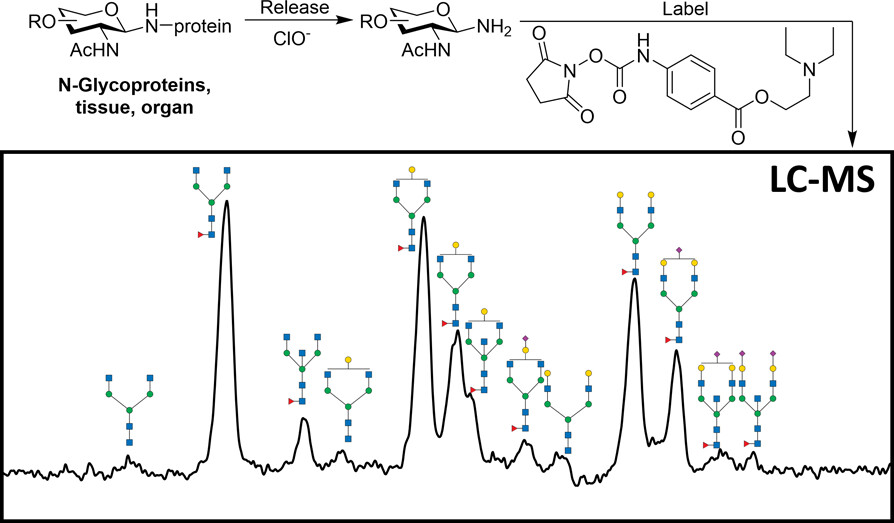Glycan Composition Analysis Service
Understanding glycan composition is a foundational aspect of glycomics. Rather than focusing on glycosylation sites, this approach targets the structural makeup of released glycans or glycan conjugates, revealing their constituent monosaccharides, modification types, and overall diversity. A detailed glycan composition profile helps uncover how glycan structures influence critical biological processes, including cell signaling, immune modulation, tumor microenvironment formation, and the quality control of therapeutic proteins.
MtoZ Biolabs offers high-resolution Glycan Composition Analysis Service designed to characterize N-glycans, O-glycans, and modifications such as sialylation and fucosylation. By combining advanced mass spectrometry platforms with tailored sample preparation strategies, we provide accurate and reproducible data for applications including monosaccharide configuration validation, glycan-type comparison, biopharmaceutical profiling, and glycan heterogeneity analysis.

Zhang, Q. et al. Anal. Chem. 2024.
Figure 1. LC-MS–Based Workflow for N-Glycan Composition Analysis
Analysis Workflow
To deliver high-confidence glycan composition profiles, MtoZ Biolabs employs a rigorously optimized workflow:
1. Sample Preparation and Glycan Release
Glycans are enzymatically or chemically released depending on sample type, with care taken to preserve monosaccharide composition.
2. Monosaccharide Derivatization
PMP, 2-AB, or other derivatization reagents are used to enhance chromatographic separation and detection sensitivity.
3. Separation and Detection
Chromatographic techniques such as HPLC, UHPLC-MS/MS, or GC-MS are applied to resolve isomers and detect derivatized sugars with high specificity.
4. Data Processing and Composition Analysis
Peak areas are normalized using internal standards and quantitative calibrators to calculate molar ratios and relative abundances of individual monosaccharides.
5. Comprehensive Reporting and Interpretation
Deliverables include raw data, annotated spectra, quantitative results, and optional biological insights. Custom analysis support is available on request.
Why Choose MtoZ Biolabs?
✔ High-Resolution Analysis Platforms: Equipped with Thermo Fisher Orbitrap, Q Exactive HF, and Triple Quadrupole LC-MS systems to ensure sensitive and precise detection of glycan components.
✔ Flexible Chromatographic Techniques: Supports HILIC, RP-HPLC, and GC-MS separations to accommodate different glycan polarities and derivatization strategies.
✔ Broad Monosaccharide Detection Spectrum: Enables identification of both common and rare monosaccharides, including neutral sugars, sialic acids, fucose, and amino sugars.
✔ Robust Quantification Performance: Offers relative or absolute quantification using internal standards or isotope labeling, ideal for multi-sample comparisons and biomarker discovery.
✔ Extensive Sample Compatibility: Accepts serum, plasma, cultured cells, tissues, plants, vaccines, and other biologically relevant matrices.
✔ Customizable Report Outputs: Provides comprehensive data tables, total ion chromatograms, relative abundance charts, and glycan structural annotations tailored to research needs.
Sample Submission Suggestions
Our Glycan Composition Analysis Service is compatible with a wide variety of biological samples, including but not limited to recombinant glycoproteins, serum, plasma, cell lysates, tissue homogenates, dairy products, and vaccine formulations.
We recommend submitting samples that are highly purified and sufficiently expose glycan structures. For project-specific guidance, please contact MtoZ Biolabs to receive our detailed sample submission instructions. We also offer full support for sample pretreatment and derivatization workflows.
Applications
· Consistency evaluation of recombinant glycoproteins and vaccine candidates
· Characterization of cancer- or immune-related glycan alterations
· Monosaccharide profiling in plant-, microbe-, or fungus-derived glycans
· Efficiency monitoring of glycan synthesis and glycoengineering workflows
· Quality control and component profiling of functional oligosaccharide products
What Could be Included in the Report?
1. Comprehensive Experimental Documentation: Detailed record of sample processing, glycan release, and derivatization procedures
2. Reagents and Instrumentation Summary: List of chemicals used, chromatographic systems, and mass spectrometry settings
3. Monosaccharide Composition Table: Includes sugar types, molecular formulas, theoretical masses, and relative abundances
4. Annotated Glycan Spectra: Representative total ion chromatograms, labeled sugar peaks, and structural interpretations
5. Optional Bioinformatics Insights: Functional analysis and glycan modification pattern predictions are available upon request
6. Raw Data Files: Complete mass spectrometry files and chromatograms for further analysis or archival
The Glycan Composition Analysis Service provides a powerful platform for revealing the glycan makeup of complex biological samples. MtoZ Biolabs also offers complementary services including glycosylation site identification, glycan structure elucidation, linkage analysis, and site occupancy determination. Together, these services enable multidimensional analysis of glycosylation and support the comprehensive advancement of glycomics research.
Get in touch with us to discuss your project goals. We are here to provide tailored solutions and expert support to accelerate your discoveries in glycoscience.
FAQ
Q1: Can this service detect all types of monosaccharides?
Yes. The Glycan Composition Analysis Service supports identification of most common sugar types including neutral sugars, sialic acids, fucose, and amino sugars. For rare monosaccharides, please consult with us during the planning stage to confirm analytical compatibility.
Q2: What is the difference between glycan composition analysis and structural elucidation?
Composition analysis focuses on identifying the types and relative amounts of monosaccharides present in glycans. It provides a macroscopic overview of glycosylation. Structural analysis examines linkage order, bond types, branching, and isomerism. It involves higher complexity and often requires MSn, NMR, or enzymatic digestion. Both approaches are complementary and chosen based on research depth and objective.
Q3: How do derivatization strategies like PMP and 2-AB impact results?
Derivatization methods differ in terms of sensitivity, resolution, and MS compatibility. PMP is ideal for UV detection and LC-MS applications, offering stable derivatives and gentle reaction conditions. In contrast, 2-AB and 2-AA are suited for fluorescence-based detection and high-throughput quantification. Our team will select the most appropriate method based on your sample type and analytical goals.
Q4: Can this service monitor dynamic glycan changes under experimental conditions?
Yes. In addition to static comparisons, our Glycan Composition Analysis Service supports time-course studies and glycan dynamics under treatments such as drug exposure, stress, or cell activation. Parallel batch processing and isotope-based quantification strategies enable high temporal resolution for mechanistic or pharmacodynamic studies.
Related Services
Glycoprotein Separation and Purification Service
Glycoprotein Peptide Enrichment Service
How to order?







